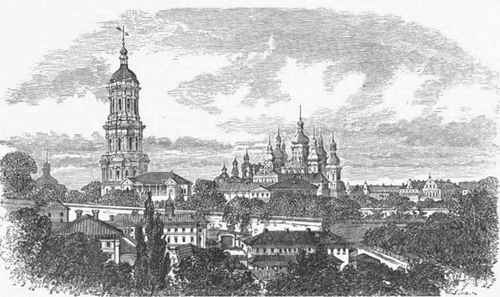Kieff, Or Kiow Kiev
Description
This section is from "The American Cyclopaedia", by George Ripley And Charles A. Dana. Also available from Amazon: The New American Cyclopędia. 16 volumes complete..
Kieff, Or Kiow Kiev
I. A S. government of European Russia, bordering on Minsk, Tchernigov, Poltava, Kherson, Podolia, and Volhynia; area, 19,682 sq. m.; pop. in 1867, 2,144,276. Kiev is the most fertile part of the Ukraine or Little Russia. Its surface is a plain, here and there undulating, and near the river courses intersected by low ranges. It is watered by the Dnieper, which forms its boundary on the side of Tchernigov and Poltava, and its western affluents, the Pripet, Ros, and others, the streams which take their course to the Bog or southern Bug being unimportant. There is abundance of grain of all kinds, of hemp, flax, honey, wax, and tobacco, excellent timber, and cattle of very good breed, the latter forming a principal article of export. The climate is generally very mild and dry; excessive heat prevails in summer. Agriculture and cattle breeding are the chief occupations of the inhabitants, who consist mainly of Little-Russians. The manufactures are unimportant. Trade is in part carried on by Jews, who are numerous in the adjoining western governments. II. A city, capital of the government, on the right bank of the Dnieper, 270 m.
N. of Odessa; pop. in 1867, 70,591. It consists of four parts, the old town, the Petcherskoi or new fort, both on steep hills, the Podol or low town, between the hills and the river, and the Vladimir town, which was added to the former by the empress Catharine II. The old town, which in the times preceding the conversion of the Russians to Christianity, under Vladimir the Great, was the principal seat of Sarmatian and Russian heathen worship, now contains, besides several other churches, the cathedral of St. Sophia, a magnificent structure of the 11th century, and the palace of the Greek metropolitan. The fort contains the great Petcherskoi monastery from which it received its name, and which, together with the bastions and walls of the place, and the glittering gilt and colored cupolas of the churches on the neighboring eminences, makes a strong impression upon the traveller who approaches the city from the other side of the Dnieper. This division embraces the barracks of the garrison, the arsenals and magazines, the houses of the officers, the palace of the governor, numerous churches, and the renowned catacombs of St. Anthony, consisting of excavations in a precipitous cliff on the banks of the river, which attract numberless pilgrims from all parts of Russia through veneration for the saints whose bodies are there preserved.
Adjoining are the catacombs of St. Theodosius, which contain a smaller number of saints. The Podol, which is the commercial part of the city, is regularly laid out, and embellished with gardens. Kiev has a large university, founded in 1834, to which are attached a library and cabinets of medals, zoology, mineralogy, and botany. There are also various other institutions of learning, of which the Greek theological academy in the Petcherskoi monastery is the best endowed and most frequented. The manufactures and trade of the city are not important. Railways connect it with Moscow and St. Petersburg, Odessa, and Lemberg. A magnificent bridge, recently constructed, spans the Dnieper. - The earliest history of Kiev is traced by some to the time of the Greek colonies near the N. coast of the Black sea; others place its foundation in the 5th century. In the last quarter of the 9th century it became the residence of the princes of Novgorod. As the capital of Christianized Russia, it was adorned in the 11th century with a great number of churches. After the middle of the 12th, however, it was deprived of its rank, and subsequently suffered by the devastations of the Tartars, the Lithuanian and Polish wars, the plague, and fires.
After having been for about three centuries in the hands of the Poles, it was reannexed to Russia by the peace of 1667.

Kiev - the Petcherekoi Monastery.
Continue to:


